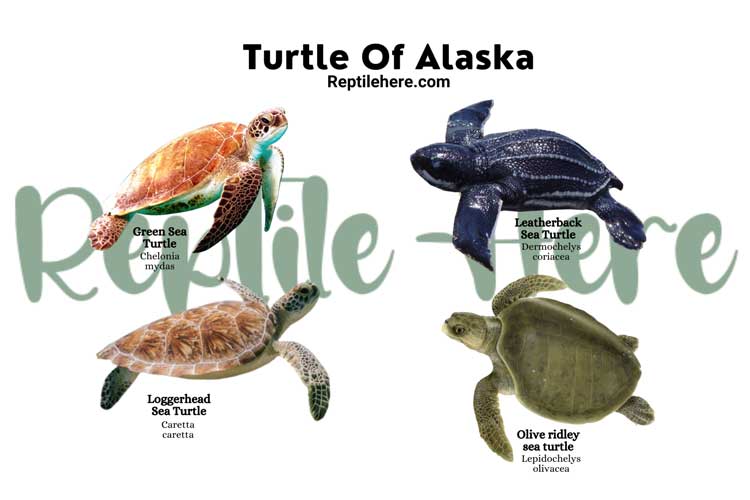Turtle Of Alaska – 4 Species That are Found Here
Alaska boasts its place as the largest state in the USA. On top of this, it is home to 4 main species of seawater turtle species namely the leatherback, green sea, Olive ridley, and loggerhead sea turtles.
However, the state doesn’t have any freshwater species. The limited number of turtle species is due to the cold waters of Alaska which are a threat to turtles given that they’re cold-blooded animals and can’t control their own body temperatures.
Below, we get into the full details of the complete list of the turtle species in Alaska, including quick facts about each of them.
4 Types Of Turtle Of Alaska
Contents
1. Leatherback sea turtle
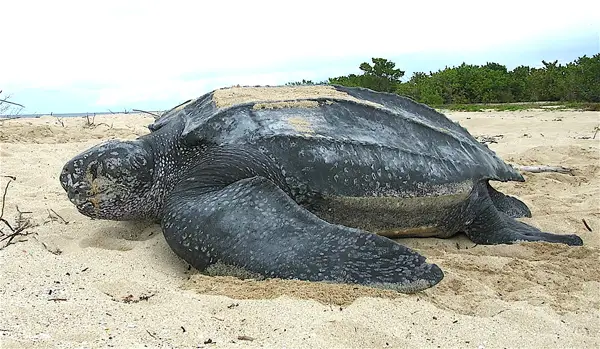
- Scientific name: Dermochelys coriacea
- Common name: leathery turtle, trunk turtle, Lute turtle, luth
- Family: Dermochelyidae
- Size: 5 to 6 feet
- Lifespan: 50+ years
- Conservation status: Vulnerable
The leatherback sea turtle is the most common turtle species in Alaska. The turtles are found in the sea and are known to grow to mammoth sizes (up to 6 ft.!). An average adult can also weigh as heavy as 540lbs!
Leatherback turtles usually have black shells. And they differ from other species of turtles with their smooth leathery carapace and skin. Their upper shell is made up of a flexible layer of dermal bones covered by tough and oily connective tissue and smooth skin.
The body of this turtle is barrel-shaped and then tapered to the rear. They have a total of 7 longitudinal dorsal ridges and their whole body is almost completely black, with some variable spotting.
Leatherback turtles have tooth-like cusps that work closely with their sharp-edged jaws to enable them to easily feed on jellyfish, salps, and other gelatinous zooplankton.
As for the habitat, these Alaska sea turtles are fond of tropical and subtropical waters all year round. But they tend to migrate to cooler, temperate, and boreal waters during warm weather.
Note that this species is highly migratory and can swim as many as 10,000 miles in a year between foraging and nesting grounds. They’re also excellent divers—with the deepest diving record standing at whopping 4,000 feet!
Between 1963 and 1993, NOAA Fisheries Alaska Regional Office reported a total of 19 leatherback turtles in Alaska, most spotted in July and August, and the numbers have most likely grown since then.
These turtles are an endangered species due to human interference in their habitats which causes only 1000 hatchlings to survive.
2. Green sea turtle
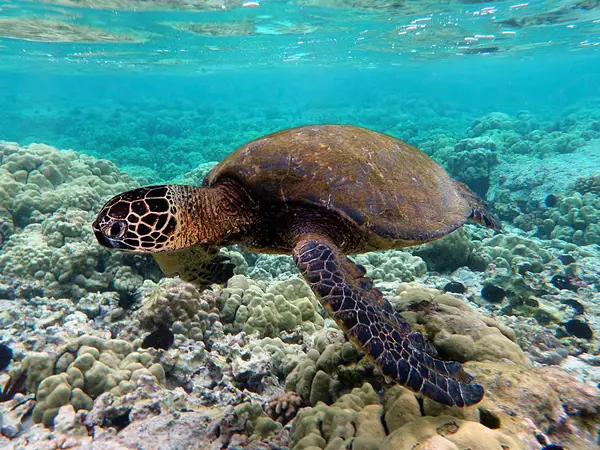
- Scientific name: Chelonia mydas
- Common name: Green turtle, Pacific green turtle, Black sea turtle
- Family: Cheloniidae
- Size: 2 to 5 feet
- Lifespan: 60 to 70 years
- Conservation status: Endangered
The green sea turtle species is classified among the largest hard-shelled sea turtles in Alaska. It can reach up to 4 feet in length and weighs up to 400lbs.
This species is characterized by scutes that run down the middle; they’re 4 on each side. The shell color can be gray, dark brown, or olive with a yellow-to-white bottom shell or plastron.
It also features a serrated beak on its lower jaw and two large scales resign between the eyes.
Males are generally larger than females and have longer tails. The females lay their eggs on the beach and use their paddle-shaped flippers to easily burrow in the sand when laying eggs. A single green turtle can lay up to 200 eggs!
This Alaska sea turtle species gets its name from its primary diet which consists of age and seagrasses (mind you, this diet is responsible for tinting its cartilage green).
Green turtles are usually found in tropical as well as subtropical waters throughout the years. They also tend to migrate to cooler temperatures and even boreal waters when the weather gets warmer.
A total of 19 green sea turtles were reported in Alaska between 1976 and 2020, with most of them occurring between October and December. These turtles are classified as endangered in Alaska.
Also read: Turtles in Missouri
3. Olive ridley sea turtle
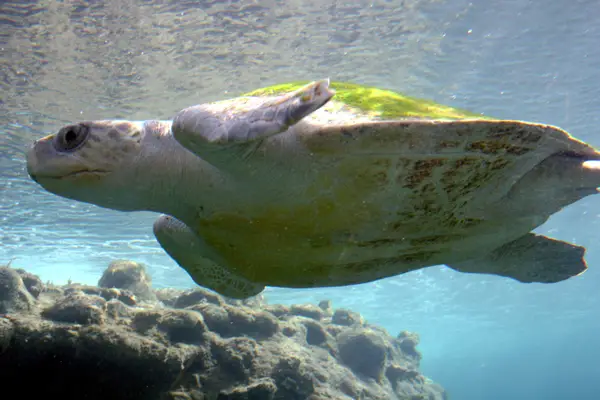
- Scientific name: Lepidochelys olivacea
- Common name: Pacific ridley sea turtle
- Family: Cheloniidae
- Size: 2.5 feet
- Lifespan: 50 years
- Conservation status: Vulnerable
Olive ridley sea turtles are much smaller than other species of sea turtles. They reach a maximum of 2.5 feet in length and weigh up to 100 pounds. And they have an average lifespan of up to 50 years.
An olive ridley sea turtle has a heart-shaped carapace with olive to grayish-green in color. The shell features around 5 to 9 scutes. These turtles are generally omnivorous and feed on crustaceans, fish, jellyfish, mollusks, algae, and salps.
These Alaska sea turtles can opt to nest in large groups or by themselves. In the event of a mass nesting, the female turtles usually gather in large groups offshore on the nesting beaches. This is then followed by a vast number of turtles moving ashore to nest (this event is usually referred to as arribada, a Spanish word for arrival).
The arribada is marked by numerous (hundreds of thousands) pregnant females coming ashore to lay eggs. Due to the high density of nesting experienced at the nesting beaches, the females end up digging up clutches of eggs laid by other females as they try to find a place for their eggs.
Olive ridley turtles of Alaska are usually found in tropical and subtropical waters all year round. Though they tend to migrate to boreal waters when the climate gets warmer.
The last report dated July 2004 shows that 4 olive ridley turtle species have been spotted in Alaska so far. Note that these turtles are classified as threatened.
4. Loggerhead sea turtle
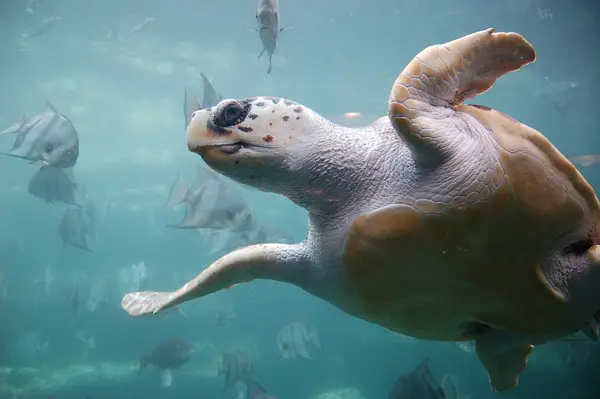
- Scientific name: Caretta caretta
- Common name: Loggerhead, Loggerhead Sea-Turtle
- Family: Cheloniidae
- Size: 3.5 feet
- Lifespan: 70+ years
- Conservation status: Endangered
Loggerhead sea turtles boast their place as the most abundant sea turtle species in the United States and are found in many states, including Alaska.
These turtles are pretty big and can reach up to 3.5ft in length. They weigh up to 350 pounds and can live for a whopping 70 years or more.
A loggerhead in Alaska is distinguished by a slightly heart-shaped carapace that’s reddish brown in color, with pale yellow plastron. Some species also feature yellow-bordered scutes.
This turtle species gets its name from its large head. It has powerful jaws that enable it to feed on a variety of foods including conch, whelks, insects, jellyfish, gastropods, and algae.
The loggerhead turtles in Alaska are usually found in temperate, tropical, and subtropical waters all year round. However, they also tend to migrate to cold boreal waters on rare occasions, for instance, during El Nino weather.
Only 2 loggerhead turtle species have been spotted in Alaskan waters.
Related: Turtles Of Arizona
Conclusion
Alaska, the largest state in the US, is home to 4 turtle species namely leatherback, green sea, loggerhead, and olive ridley sea turtles. However, the state doesn’t have fresh water or box/land turtle inhabitants.
Overall, the number of turtle species in Alaska is on the lower side compared to other states. And this is attributed to the cold Alaskan waters which are a threat to turtles due to their inability to control their own body temperatures.


